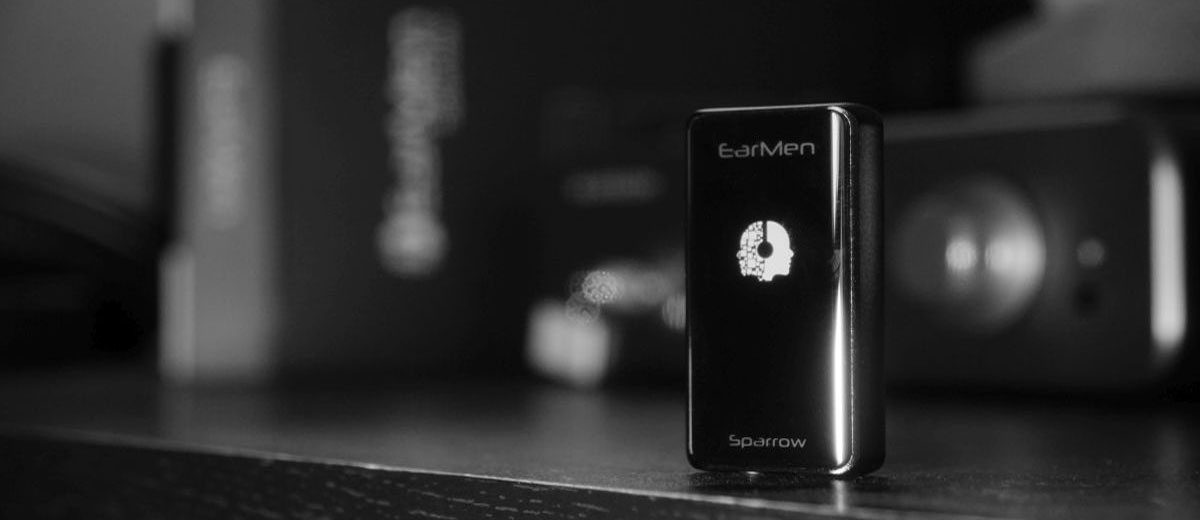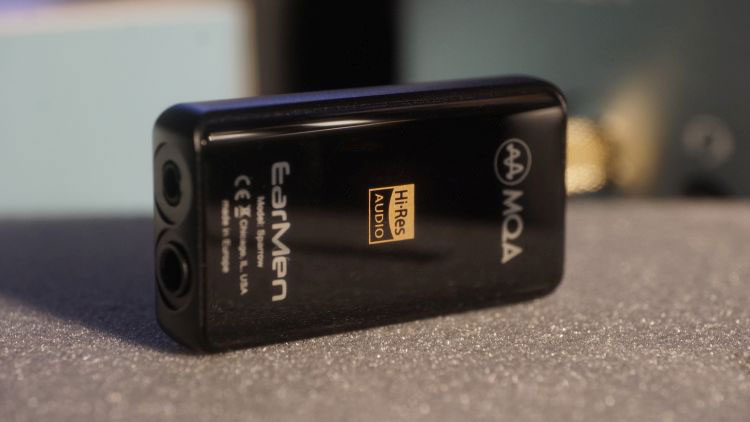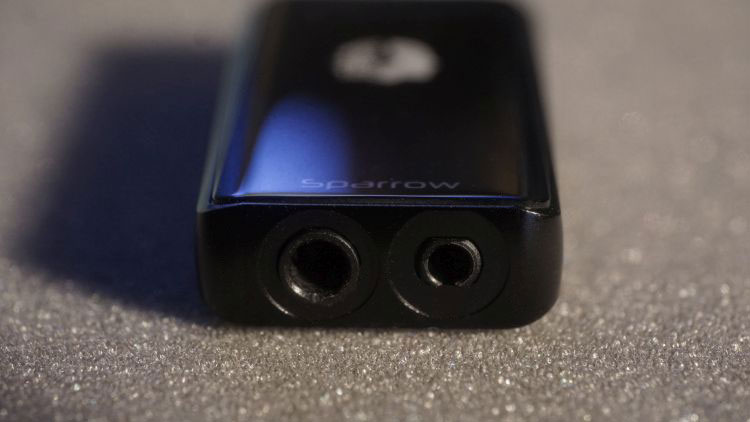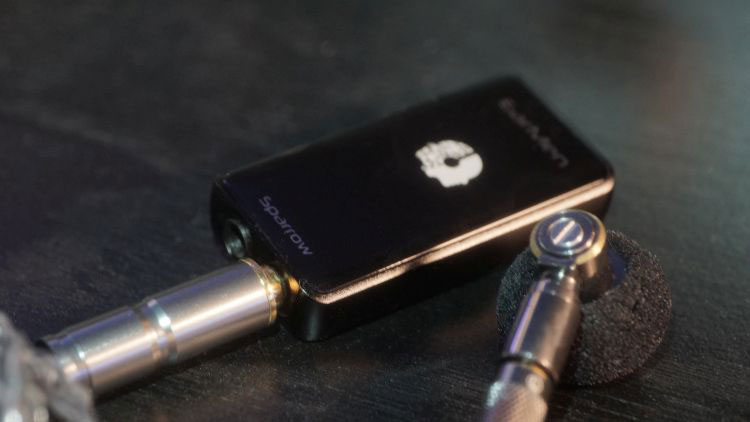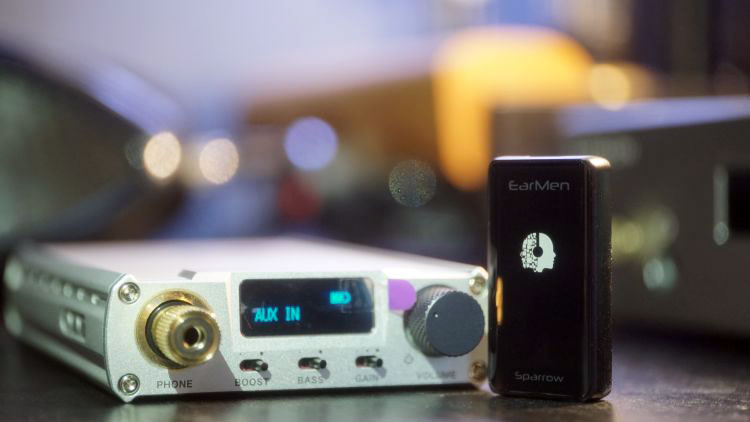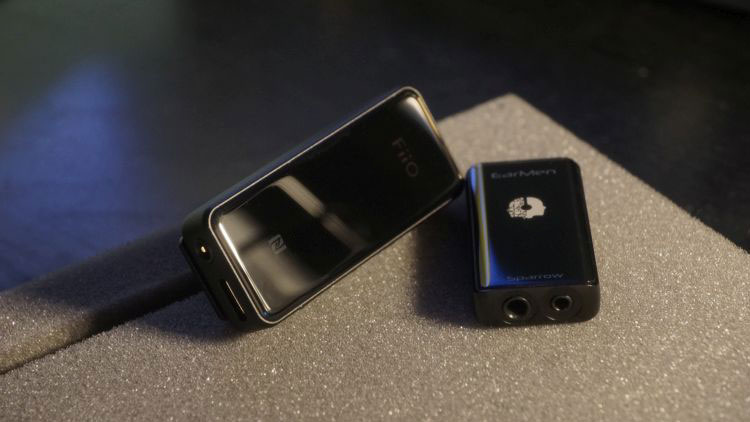The Earmen Sparrow is a miniature USB DAC, preamp, and headphone amp featuring an ES9281PRO and offering MQA compatibility. It is priced at $199.
Disclaimer: The Earmen Sparrow sent to us is a sample in exchange for our honest opinion in this review. We thank EarMen for this opportunity.
To learn more Earmen reviews on Headfonics you can click here.
Note, this review follows our new scoring guidelines for 2020 which you can read up on here.
The Earmen Sparrow is a $199 ultra-portable DAC that functions both with a computer, as well as a phone. I have to say, the market for these types of DAC/amps has been flooded lately. I have reviewed half a dozen in the second half of this year alone.
Competition is brutally fierce, so let us see what Earmen has to offer the audiophile community with their Sparrow.
Packaging & Accessories
The box is a-typical, just a standard cardboard box with some printed media on it. Inside, a foam cutout for the Sparrow itself, as well as interconnect cables.
I am incredibly happy that they included them, but as with most DAC’s these days, no iOS cable. Is it a big deal? Well, no. I do not blame companies anymore for this lack of an iOS interconnect.
Apple forces us to use a god awful OTG thing that is large and cumbersome, so we can use a standard iOS data cable on that side of the absurdly long chain as it is. Android users do not have this problem. Maybe Apple will wise up soon? Nah…
I am super happy Earmen included the needed Android cables. That makes me happy. The included interconnects are roughly 3 inches in length and play into the very portable conscious mindset of this product as a whole.
Glad to see they did not slap in a 5ft long cable and call it a day. One interconnect is a USB-C to USB-C. The other, standard male USB to USB-C. This is the cable you will need for charging and also for the iOS OTG adapter, which connects to that adapters USB female port.
Design
Excellent design quality all around. This DAC/amp feels dense for such a little design. It feels of “quality” when you hold it and does not feel cheap in the slightest. I am glad to report that the balanced 2.5mm and standard 3.5mm ports do not wiggle or appear/feel loose in the slightest.
The USB-C port also has no physical play movement either. Overall, I am very satisfied with the price tag of $199 and the design quality offered. I have seen janky plastic materials used in much more expensive products in the past.
Output Power
The Sparrow’s 3.5mm port allows for “up to” 2Vrms worth of power, which equates to roughly 80mW. Up to 4Vrms in 2.5mm balanced mode, which clocks in at about 360mW (I am rounding up for the sake of decimal places).
Despite that draw seeming a bit on the low end for need over ears, I get plenty of volume out of even the absurdly hard to drive Dan Clark Aeon2 RT closed-back headphones.
This Sparrow maxes out in 2.5mm balanced at 0.316mW. Or roughly 1/3 of one Watt.
As mentioned, this is fine for IEM’s and earbuds. It really has some driving problems with most of my gear of the larger variety though. Volume push is not the same as proper driving voltage, so you get plenty of volume out of somewhat needy headphones still. But they ended up sounding rather weak.
This is the same result with nearly every single portable DAC like this, so this is not uncommon. These little DAC’s are meant for portability and not to drive your Audeze Planar headphones.
With my CIEM’s, or higher-end earbuds, the Sparrow has plenty of push to get the job done and not sound overly thin. I enjoy it.
MQA & DSD
It is always nice to see MQA support in such a small little thing. I do not have much of an MQA inventory, so I purchased some for myself. A smaller file size feels nice, but gods honest, these days, I am streaming more than anything else.
If you are cool enough to drop some MQA into your phone storage, then you will absolutely prefer MQA over FLAC. I am quite astounded by the raw slickness in some MQA experiences I have had during this review process. Call me a believer.
I have almost never spoken about MQA, but having spent a few weeks with it now, I am can say that I think my FLAC inventory is obsolete. From here on, I will likely be opting for this in the future as often as I can.
DSD files tend to showcase a lot of rawness, I am still waiting for some albums that I am personally interested in that I stumble across that are highly musical instead of painful. But that is my subjective listening experience.
The objective side…I’ve plenty of albums I really do not like, but sound phenomenal in high-quality options like these. So dang…I was pretty shocked when I started up some DSD and swapped over to MQA. I guess this is the future. Time to start converting, I suppose.
I love that I made the jump to Streaming services only to be pulled back immediately into MQA and super high DSD quality…this hobby, sometimes…sigh.
Sound Impressions
Bass
This Sparrow has no physical controls, all you get is a light indicator of what type of connection you have. So, all boosting needs are required to be altered in the software, or through your extra amp if you are using one that has onboard bass boosting.
The Sparrow is not neutral, it certainly has a bitty bump in the low regions whilst using a flat EQ set. With no DSP or EQ active, I can denote more bass than something like my FiiO BTR1K, as well as the recently reviewed Hidizs S9. Both of which sounded less bassy.
Now, those are cheaper than the Sparrow by almost half, so you can really taste and sense the upgrade in fidelity on the bass side with the Sparrow. Lovely really, it is what I consider musical, but not overly saturated.
Bass Texture
The older Hidizs S8 sounds less interesting than the S9, both of which are creamed by the much larger and powerful xDuoo XD05+, which is my daily go-to for portability needs these days.
It has a bass boost switch that really amplifies the bass potency and depth quite nicely, however, it destroys the texture and micro details. The Sparrow does not have that problem and I was astounded to hear the subtle variances in bass detail and microdynamics that were totally lost on the xDuoo.
This is a great little DAC, if you like some interesting texturing and layering, with just a hint of extra oomph, this is a great option for you. It responds fairly average-like with EQ additives. Meaning, you can boost up to about +5dB before things get murky.
Mids
This DAC is very mid-centered and enjoyable. My Audio Technica ESW11LTD sings so well with this DAC that I am considering shelving the XD05+ when I use the ESW11LTD on the go.
The midrange is bloomed, certainly offering a mid-centric bump and boost in those frequencies, no doubt. So, naturally forward and vocal-centric headphones sounding amazing with this Sparrow. And they certainly do.
My UcoTech ES-P1 earbuds sound particularly good, more physically enjoyable than with my xDuoo or the recently reviewed S9 from Hidizs. However, I notice a bit of a subjective gripe in the physicality factor the midrange offers. It is maybe too smooth for me.
Usually, on the go, I want something a little punchier and dynamically more interesting. But this Sparrow is soft and gentle by comparison to the other few small DAC’s I have recently written about. I would call the Sparrow super refined in that regard.
You can really dig out that smoothness factor and draw borders around the vocalist and instrument, it is incredibly detailed in that sense. Whereas the other few DAC’s I have mentioned, house a more omnipresent sound field for the same instrument in the same track, same headphone, and with volume as equalized as I could manage between them all.
Treble
The top side of this DAC is butter, pure buttery smooth. Swapping back to the S9 and the ColorFly CK10 that I reviewed a long time ago, which I still use because it is so musical and fun, this Sparrow crushes the top ends of those DAC’s something fierce.
This is a much more “refined” (there is that term again) experience than the others, which clearly house more grit and less clarity. Also, they are mostly all harsher to listen to and grainy overall. I really love this Sparrow, whoever designed it did a really great job with it.
At the $199 level, it is performing on par with the stock xDuoo XD05 original, not the upgraded + variant that I usually use. And that is saying something.
The downside I foresee is for those who want more bite and zing to the top side. Again, this is an exceptionally smooth sounding product overall. So, it might not be the right product for those who have treble happy headphones and want that impressive density factor and sparkle.
What is here, is refined, yes. But, also reserved in quantity. I consider this the “Dude, leave me alone, I am going to just chill out somewhere, I had a rough day” type of a tone. Reference or Analytical is not what I would use to describe this.
However, it is still clean enough to be audibly superior to the other small DAC’s I have mentioned in this review so far.
Imaging
Ah, the weak point. The Sparrow sounds just as wide as the ColorFly and the Hidizs, but it also sounds noticeably more deep feeling and realistically formed with vocals and instruments.
You can really centralize and localize the beginning of the sound source, vs not being able to do so in the others I have mentioned. I would not call this a prime DAC experience at $200, as there are some others in the desktop sizes that outperform it.
But, for the smaller DAC options out there, such as The DragonFly, Hidizs S-series, the CK10, the FiiO BTR5-type small DACs in this design tier…this Sparrow does a great job with the depth factor in the image void.
There is certainly a clear step up when going from the Hidizs S9 or the Colorfly CK10 to this Sparrow, you can feel the curtain forward just remove itself and you can place the layering of the recording more easily from your location to the furthest point. IE-X2: The Cavern Effect.
Our Verdict
Hey now, Earmen is on the move! They have made some good stuff lately and I am glad to have experienced them. This Sparrow is a keeper.
So, what are my gripes? The lack of physical buttons. I understand it is a small portable DAC, but I would prefer it to be just a bit bigger to allow for some physical buttons on it that are useful. Bass boost maybe, a gain switch? Something would be nice instead of nothing.
I love the balanced and unbalanced options. Thank god for practicality now these days vs the absurd need for a symmetrical design. It is so oddly refreshing to see the two jacks right next to each other in this manner. Screw symmetry! I will take practicality and useful design over something perfectly symmetrical any day.
This a great little DAC, easily one of the better ones. As mentioned, I have been using the ColorFly CK10 for a while, because I found it to be the most fun and energetically amusing of the lot.
But this Sparrow is like the opposite of that CK10, it is smoother and exudes a more beautiful tonality overall. This is good entry-level Hi-Fi at the size of a matchbook.
Earmen Sparrow Specifications
| Input | USB C Female | |
| Output | 3.5 mm | |
| 2.5 mm Balanced | ||
| Power | 2.5 mm Balanced | 3.5 mm |
| 2.0 Vrms into 32 Ohm | 1.4 Vrms into 32 Ohm | |
| 4.0 Vrms into 600 Ohm | 2.0 Vrms into 600 Ohm | |
Audio Formats |
||
| DSD | 64 / 128 DoP | |
| DXD | 384/352.5 kHz | |
| PCM | Up to 384 kHz | |
| MQA Rendering | Up to 384 kHz | |

